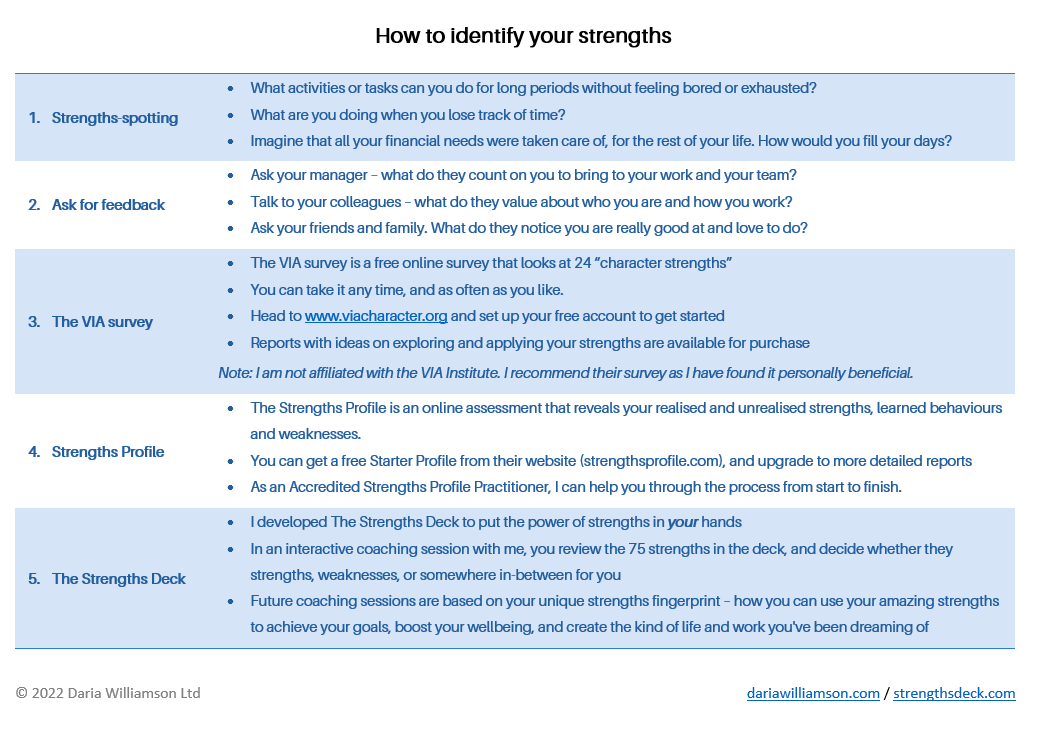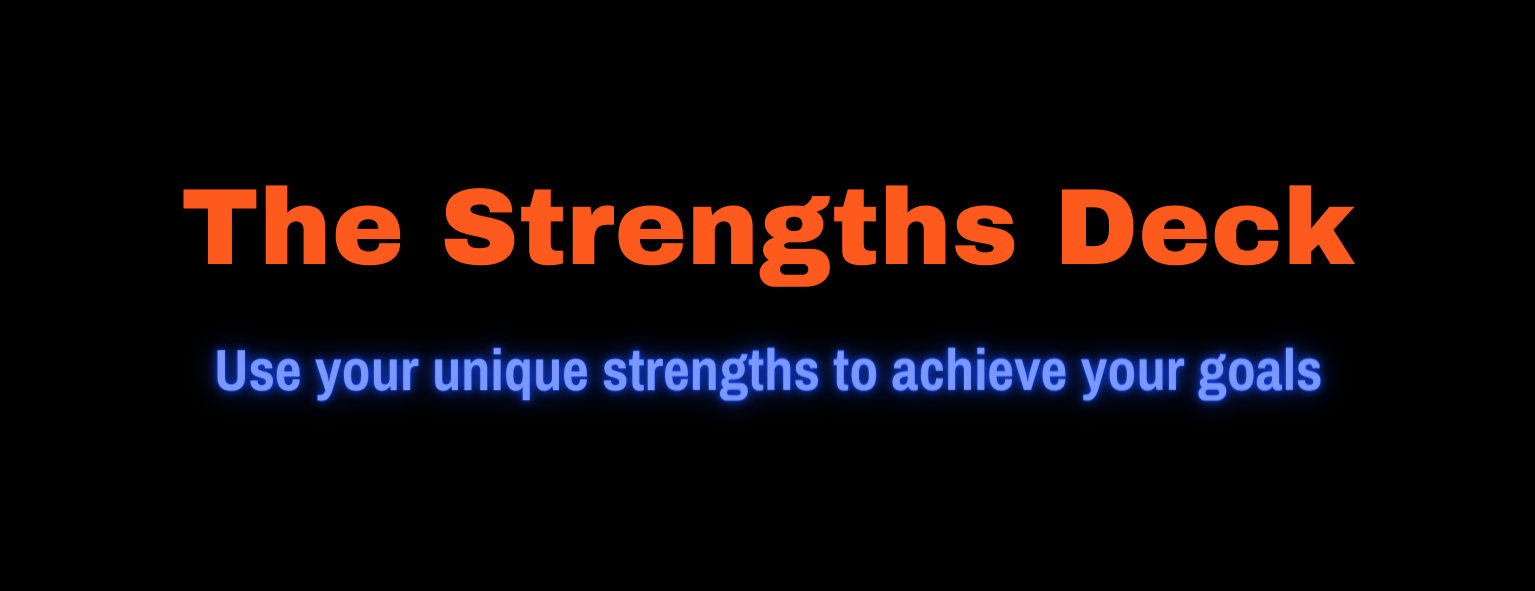This is the “capstone” strategy for this series, because it is the strategy that can wrap around all the other strategies: use your strengths.
It’s “normal” (though definitely not ideal!) not to think specifically about our strengths and how to use them well. This is largely because our business and social cultures value trying to “fix” weaknesses more highly than the concept of honing our strengths. But the weakness-focus is seriously de-energising, and dampens our ability to do great work and think really well.
The strategy of “use your strengths” can boost your performance in each of the strategies we’ve covered previously. As a refresher, they are:

What do you mean "use your strengths"?
I talk a lot about strengths with my clients. And one of the most common questions is “What do you mean when you say “use your strengths”?” Sadly, most of us have been so conditioned to think only about our weaknesses that we aren’t sure what our strengths are.
In fact, when talking to someone about this recently, they said “But I don’t have any strengths”. I was deeply saddened to realise that someone could think that way. It would feel so disempowering and disheartening. And that’s not going to encourage engagement, creative thinking, or great work.
So, when I say “use your strengths” I mean take your unique combination of what you’re good at and enjoy doing, and apply them to your life and work. You’ll be surprised at how many opportunities you have every day to make a positive difference for yourself and others, once you know what your strengths are, and how to use them strategically.
What is a "strength"?
There are a few different ways of thinking about strengths. Firstly, let’s be clear that I’m not talking about the muscles, tendons and ligaments that make up your physical body! I’m talking about inner qualities in the way you are, think, communicate, act, and relate to others.
I draw from several sources for my approach to and definition of strengths.
The VIA Institute - Character Strengths
Character strengths are positive traits/capacities that are personally fulfilling, do not diminish others, [are] ubiquitous and valued across cultures, and [are] aligned with numerous positive outcomes for oneself and others.
Ryan M. Niemiec 'Character Strengths Interventions' (2017)
Cappfinity - Strengths Profile
When people talk about strengths, most people think about ‘the things that I’m good at’... And that’s right, to an extent, but there is much more... we define a strength as consisting of: Performance (how well you perform when using these strengths); Energy (how energised you are by using these strengths); Use (how often you use these strengths)
Alex Linley & Trudy Bateman 'The Strengths Profile Book' (2018)
What these two definitions have in common is that strengths do something positive for ourselves and others. It’s not “selfish” to use a strength. And it’s not “grandstanding” to recognise that we’re good at something and that by using it, we create benefits for ourselves and others.
What strengths exist in the world?
There are many different lists of strengths available, a number of which are based on research. I think it’s important to recognise that no list of strengths will ever be “complete”. That’s because we humans are incredibly creative, adapatable and growth-oriented. So there will be things we don’t yet recognise as strengths that, in the future, will seem completely obvious. That said, I find the 24 strengths of the VIA Institute, and the 60 strengths of Strengths Profile (download) to be easy to understand and work with. I also reference the CliftonStrengths definitions occasionally.
The main thing to take away from this is that we all have many strengths, in different combinations. That’s why involving others in our thinking makes it better – each person brings their own strengths to the table.
What are my strengths?
It’s quite normal (but definitely not ideal!) to be uncertain of what your strengths are. And, of course, it’s very hard to use your strengths if you don’t know what they are.
The great news is that working out your strengths doesn’t have to be a long and involved process. Check out the table below for four simple ways to identify your strengths.

So, once you know your strengths, how can you use them?
It’s one thing to know what we’re good at – it’s something else entirely to apply it to our lives and work. Given the title of this series, I’m going to be talking about using your strengths in the context of idea generation.
Firstly, what not to do
It’s tempting when we learn about our strengths to try to use them all the time. But that can reduce our performance instead of increasing it. Why? Because if we rely too heavily on any of our strengths, we can burn them out, and they become de-energising for us. Then we shy away from them, temporarily losing one of our super-powers.
Overuse of our strengths can also alienate people around us. One of my top strengths is narrator/story-teller (which is why my articles take at least 5 minutes to read!). If I don’t pay attention to my use of this strength, I annoy people who have strengths in decision-making and action. What I see as context and anticipation-building, they see as fluff and barriers to getting the information they need to get things done.
Perhaps you’ve experienced a situation where someone kept joking around, even though it was important to have a serious discussion. Their over-use of humour probably got in the way of what was necessary, useful and valuable.
The key here is not to over-emphasise any strength, but to dial them up and down as suits each situation.
What to do #1 - identify which of your strengths will be helpful
Not all of our strengths are useful in all situations. Take time to think about what you’ll be thinking about. This is like the blue hat in the Six Thinking Hats approach I described in Strategy 7 (don’t prejudge your ideas).
Select one or two key strengths that you believe will help you think creatively and flexibly, and work well with others. Come up with a few ways that you can use these strengths (wisely!) during the thinking process. Check out the Resources section below for a link to an exercise to practice using your strengths.
What to do #2 - combine your strengths
Sometimes, the things we’re thinking about might involve our learned behaviours (things we’re good at but don’t find energising) or weaknesses (things we’re not good at and don’t find energising). We’re not doomed to failure! We can combine our strengths to help us overcome the de-energising nature of our learned behaviours or weaknesses.
Maybe you find taking action quickly and decisively to be de-energising. If you have a strength as a Catalyst, you can inspire others to make things happen, so you don’t need to do it all yourself. Or if you have a strength of Service, you can change the way you think about taking action, and think of it as a way to serve others.
Or maybe you find Creativity is quite draining, but you can think deeply about things (the Incubator strength), see things from fresh perspectives (the Counterpoint strength) and identify opportunities for growth (the Improver strength).
The key is to pair strengths that are energising with areas that might be de-energising. The Resources section at the end of this article has a link to a technique to help you do this.
What to do #3 - identify other people's strengths and how to combine them
Thinking is often best done as a team sport. You can help your thinking team succeed by identifying the strengths that other people bring to the table.
Use the strengths-spotting tips above to spot your colleagues’ strengths. Once you know what they bring, look for ways to harmonise the strengths so that the whole group’s thinking is deeper, broader, more creative, innovative and strategic.
What to do #4 - think about what strengths might be missing
It’s relatively common, especially if working in functional groups, for certain strengths to be “popular” (shared by many in the group) while others are “unpopular” (few if any group members exhibit them).
Because each strength has the potential to create positive outcomes, it can be helpful to identify if any useful strengths are under-represented in your group. If that’s the case, then Strategy 8, using a facilitator, can be quite helpful, as you can choose a facilitator who can contribute in that strength area. Or you can bring in other colleagues who shine with those strengths – an easy way to execute Strategy 4 – involve others.
Apply your strengths
Once you’ve recognised your own, and other people’s, strengths, and found ways to combine them and bring in any that are missing, you’re on your way to great thinking.
As you work through your thinking sessions, check in regularly to see which strengths are being used, and which are still “on the bench”. A good way to do this is to write up a list of the key strengths in the room, and check whether they’ve all been featured. If any haven’t been used, call on the people with those strengths to share their insights. You can also use this approach to check that you’re not over-using any strengths.
Finding and using your unique strengths
I believe that having a deep understanding of our strengths, and knowing how to use them wisely and well, is the pathway to increasing our sense of energy, engagement and accomplishment in our life and work.
One of my specialities is strengths-based coaching. My clients tell me that learning about their strengths has helped them discover their super-powers. They feel more alive and joyful at home and at work, and they seize opportunities and get results effortlessly, in a way they never thought possible.
Any discussion of personal strengths would be incomplete without me letting you know about The Strengths Deck.
I created it to put the power of strengths in your hands. If you want to learn about your unique strengths fingerprint and how to make the most of your amazing strengths, click the logo to find out more, or make a booking for your free, 30-minute call to talk about how we can get your strengths working for you.
The end of an era (or this series, at least!)
This series on “How to have great ideas” is now complete.
The ten strategies are:

Shortly, I’ll be kicking off a new series, called “How to turn great ideas into great results”. This will cover off how to choose from all the different ideas you have generated, and how to put them into practice so that you get the outcomes you desire.
If you want to be the first in the know when the first strategy in the new series is published, or if you want to hear about other articles that will help you get the “human” stuff right, sign up to my newsletter below.
Resources
- The VIA Institute on Character
- Strengths Profile by Cappfinity
- How to Put Your Strengths to Work – sourcesofinsight.com
- Exercise: Use Your Strengths – Greater Good in Action
- How to Use Your Strengths to Overcome Your Weaknesses – Psychology Today






